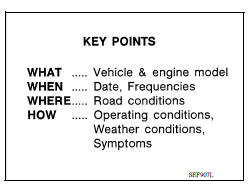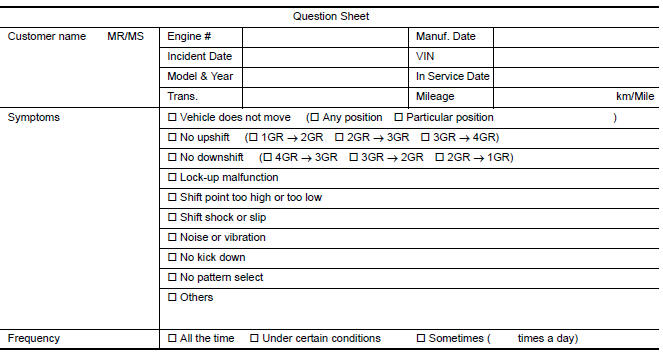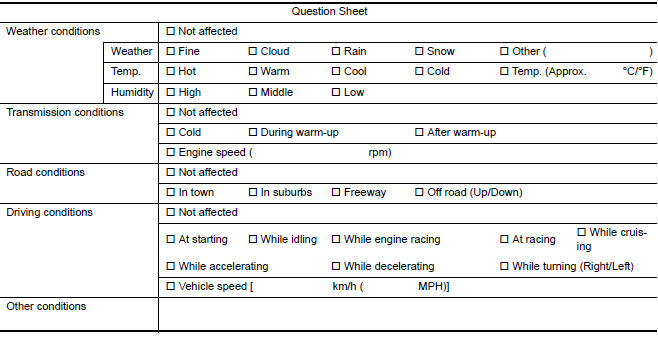Nissan Versa (N17): Diagnosis and repair work flow
Work Flow
1.OBTAIN INFORMATION ABOUT SYMPTOM
Refer to TM, "Diagnostic Work Sheet" and interview the customer to obtain the malfunction information (conditions and environment when the malfunction occurred) as much as possible when the customer brings in the vehicle.
>> GO TO 2.
2.CHECK DTC
- Before checking the malfunction, check whether any DTC exists.
- If DTC exists, perform the following operations.
- Record the DTC and freeze frame data. (Print out the data using CONSULT and affix them to the Work Order Sheet.)
- Erase DTCs.
- Check the relationship between the cause that is clarified with DTC and the malfunction information described by the customer. TM, "Symptom Table" is effective.
3. Check the information of related service bulletins and others also.
Do malfunction information and DTC exist?
Malfunction information and DTC exists. >>GO TO 3.
Malfunction information exists, but no DTC. >>GO TO 4.
No malfunction information, but DTC exists. >>GO TO 5.
3.REPRODUCE MALFUNCTION SYMPTOM
Check any malfunction described by a customer, except those with DTC on the vehicle.
Also investigate whether the symptom is a fail-safe or normal operation. Refer to TM, "Fail-Safe".
When a malfunction symptom is reproduced, the question sheet is effective. Refer to TM, "Diagnostic Work Sheet".
Verify the relationship between the symptom and the conditions in which the malfunction described by the customer occurs.
>> GO TO 5.
4.REPRODUCE MALFUNCTION SYMPTOM
Check the malfunction described by the customer on the vehicle.
Also investigate whether the symptom is a fail-safe or normal operation. Refer to TM, "Fail-Safe".
When a malfunction symptom is reproduced, the question sheet is effective. Refer to TM, "Diagnostic Work Sheet".
Verify the relationship between the symptom and the conditions in which the malfunction described by the customer occurs.
>> GO TO 6.
5.PERFORM "DTC CONFIRMATION PROCEDURE"
Perform "DTC CONFIRMATION PROCEDURE" of the appropriate DTC to check if DTC is detected again.
Refer to TM, "DTC Inspection Priority Chart" when multiple DTCs are detected, and then determine the order for performing the diagnosis.
NOTE: If no DTC is detected, refer to the freeze frame data.
Is any DTC detected?
YES >> GO TO 7.
NO >> Check according to GI, "Intermittent Incident".
6.IDENTIFY MALFUNCTIONING SYSTEM WITH "DIAGNOSIS CHART BY SYMPTOM"
Use TM, "Symptom Table" from the symptom inspection result in step 4. Then identify where to start performing the diagnosis based on possible causes and symptoms.
>> GO TO 8.
7.REPAIR OR REPLACE THE MALFUNCTIONING PARTS
Repair or replace the detected malfunctioning parts.
Reconnect parts or connector after repairing or replacing, and then erase DTC if necessary.
>> GO TO 8.
8.FINAL CHECK
Perform "DTC CONFIRMATION PROCEDURE" again to make sure that the repair is correctly performed.
Check that malfunctions are not reproduced when obtaining the malfunction information from the customer, referring to the symptom inspection result in step 3 or 4.
Is DTC or malfunction symptom reproduced?
YES-1 >> DTC is reproduced: GO TO 5.
YES-2 >> Malfunction symptom is reproduced: GO TO 6.
NO >> Before delivering the vehicle to the customer, make sure that DTC is erased.
Diagnostic Work Sheet
DESCRIPTION
There are many operating conditions that may cause a malfunction of the transmission parts. By understanding those conditions properly, a quick and exact diagnosis can be achieved.
In general, customers have their own criteria for a problem. Therefore,
it is important to understand the symptom and status well
enough by asking the customer about the concerns carefully. In
order to systemize all the information for the diagnosis, prepare the
question sheet referring to the question points. 
WORKSHEET SAMPLE


Additional service when replacing
TCM
Description Always perform the following items when the TCM is replaced. LOADING OF THE CALIBRATION DATA The TCM acquires calibration data (individual characteristic value) of each solenoid t ...
Other materials:
Spark plugs
Replacing spark plugs
Platinum-tipped spark plugs
It is not necessary to replace platinum-tipped A
spark plugs as frequently as conventional type
spark plugs because they last much longer. Follow
the maintenance log shown in the Maintenance
and Schedules section of this manual. Do
not ser ...
Position switch
Removal and Installation
REMOVAL
Drain gear oil. Refer to TM, "Draining".
Disconnect the harness connector (A) from position switch.
Remove position switch from transaxle case.
INSTALLATION
Apply recommended sealant to threads of position switch.
&nbs ...
Categories
- Manuals Home
- Nissan Versa Owners Manual
- Nissan Versa Service Manual
- Video Guides
- Questions & Answers
- External Resources
- Latest Updates
- Most Popular
- Sitemap
- Search the site
- Privacy Policy
- Contact Us
0.0057

 TCM
TCM